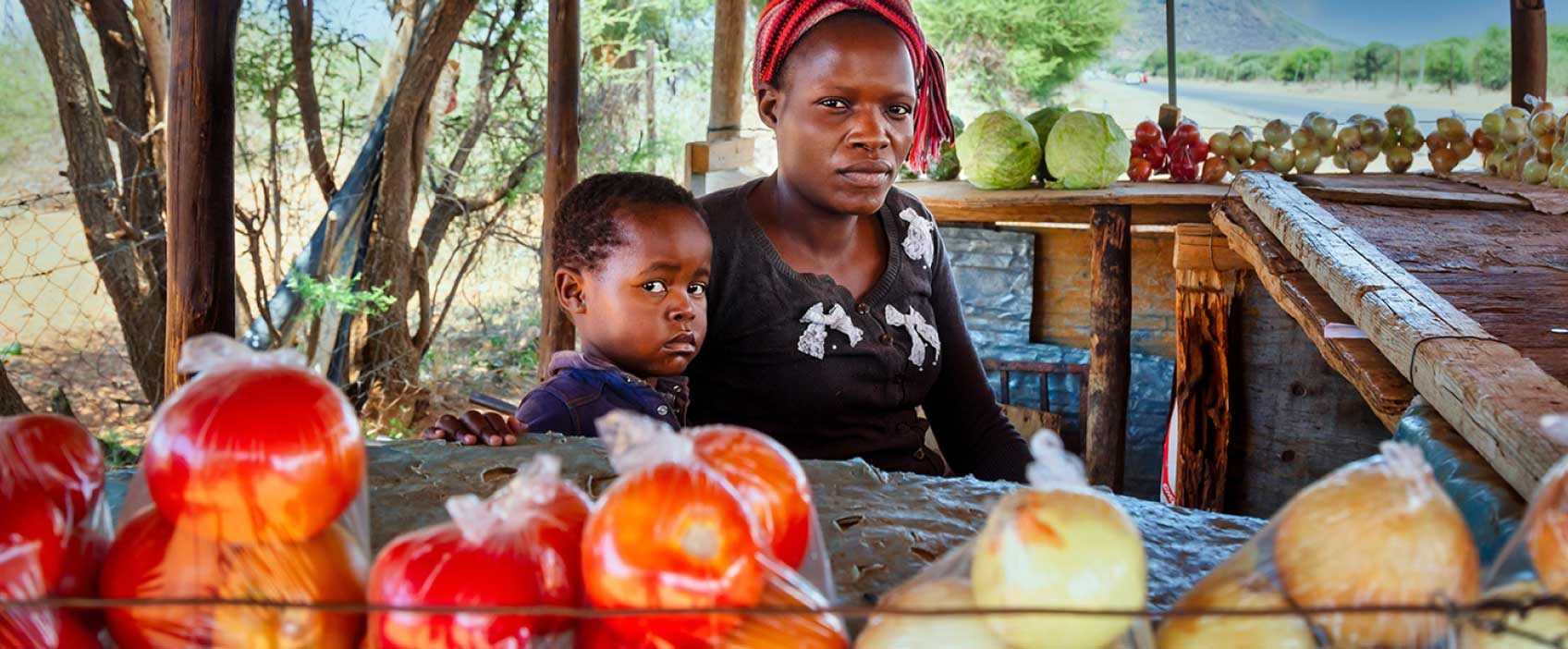
Publications and Datasets
IFPRI publications provide evidence-based insights and analysis on critical issues related to policies for food systems, food security, agriculture, diets and nutrition, poverty, and sustainability, helping to inform effective policies and strategies. Materials published by IFPR are released under a Creative Commons license, and are available for download. IFPRI authors also publish in external sources, such as academic journals and books. Where possible we provide a download link for the full text of these publications.
Featured Publications
Journal Article
Low awareness and affordability are major drivers of low consumption of animal‐source foods among children in Northern Ethiopia: A mixed‐methods study
2024Zerfu, Taddese ; Duncan, Alan J.; Baltenweck, Isabelle; McNeill, G.Journal Article
Restoring functional integrity of the global production ecosystem through biological control
2024…more
Hadi, Buyung A.R.Journal Article
Africa’s manufacturing puzzle: Evidence from Tanzanian and Ethiopian firms
2024Diao, Xinshen; Ellis, Mia; McMillan, Margaret; Rodrik, DaniExplore Our Latest Publications
By Title By Author By Country/Region By Keyword
Journal Article
Men can cook: Effectiveness of a men’s engagement intervention to change attitudes and behaviors in rural Ethiopia
Journal Article
The technopolitics of agronomic knowledge and tropical(izing) vegetables in Brazil
Journal Article
Experimental measures of intra-household resource control
Journal Article
A framework for cost-effectiveness analysis of greenhouse gas mitigation measures in dairy industry with an application to dairy farms in China
Brief
Impact of COVID-19 on food security and cropping patterns in Tajikistan: Evidence from a telephone survey in Khatlon Province
Working Paper
How have foreign exchange market distortions and conflict affected agricultural production incentives in Myanmar?
Report
IFPRI Malawi Monthly Maize Market Report, September 2024
Book Chapter
The agrifood system: structure and contribution to development goals
Book Chapter
Introduction [in Myanmar’s agrifood system: Historical development, recent shocks, future opportunities]
Book Chapter
A historical and regional perspective on Myanmar’s agrifood system
Book Chapter
Dietary quality and nutrition: Past progress, current and future challenges
Book Chapter
Vulnerability and welfare during multiple crises
Book Chapter
Agricultural land: Inequality and insecurity
Book Chapter
Livestock, capture fisheries, and aquaculture: status and recent trends
Book Chapter
Crop production: An engine in need of an upgrade
Book Chapter
Farm commercialization: A transformation on hold or in reverse?
Book Chapter
Food processing: A stalled transformation
Book Chapter
Agricultural value chains: Examples of quiet transformation
Book Chapter
The rice sector
Book Chapter
Agrifood trade
Book Chapter
Regional variations in rural livelihoods: Challenges and opportunities
Book Chapter
Conclusion: From recovery to renewal of the agrifood system
Book Chapter
Women and youth in agriculture
Book Chapter
Migration trends and implications
Book Chapter
Income diversification and the rural nonfarm economy
Book
Myanmar’s agrifood system: Historical development, recent shocks, future opportunities
Book
2024 annual trends and outlook report: Advancing the climate and bioeconomy agenda in Africa for resilient and sustainable agrifood systems
Book Chapter
Agricultural mechanization: Drivers and characteristics
Working Paper
Evaluation of the programme to reduce vulnerability in coastal fishing areas in Djibouti: Qualitative findings
Report
Does location matter? A spatial analysis of the factors influencing adoption of cereal-legume intercropping among smallholder farming households in Malawi
Working Paper
Farming for the future: Prioritization of climate-smart agriculture technologies in SAARC countries
Opinion Piece
Crafting combinations to govern groundwater: Knowledge, motivation, and agency
Working Paper
SMEs in the Food Environment in urban and peri-urban Ethiopia
Working Paper
Understanding the organizational approaches of funders and project implementers to strengthen women’s empowerment through agricultural collectives
Book Chapter
Climate risks and vulnerabilities in African agrifood systems
Book Chapter
The Impact of climate change on agriculture
Book Chapter
Innovative financing mechanisms for climate adaptation in African agrifood systems
Book Chapter
Adaptation actions to climate change in African agriculture: Effectiveness and challenges
Book Chapter
Climate action and bioeconomy transition: Mainstreaming environmental sustainability in the Post-Malabo Agenda of the Comprehensive Africa Agriculture Development Programme
Book Chapter
Introduction [in Advancing the climate and bioeconomy agenda in Africa for resilient and sustainable agrifood systems]
Book Chapter
Bioeconomy pathways: Experience from Africa, Asia, and Latin America
Book Chapter
Tracking key CAADP indicators and implementation processes
Book Chapter
A nutrition-sensitive circular bioeconomy for food systems transformation in Africa
Book Chapter
The impact of climate change on African economies and opportunities for agrifood system transformation
Book Chapter
The converging climate change and bioeconomy agendas as a pathway toward implementing the post-Malabo CAADP agenda
Book Chapter
Just energy transition: Challenges and low carbon pathways for Africa
Book Chapter
Conclusion [in 2024 annual trends and outlook report]
Book Chapter
Exploring methane emissions in Africa
Journal Article
An approach for assessing whether agricultural projects help smallholders transition to better livelihood strategies: A Malawian case study
Working Paper
Maize residue management in Myanmar
Abstract
South Asia Nutrition Knowledge Initiative: Abstract digest October 2024
Journal Article
Toward integrated dam assessment: Evaluating multi-dimensional impacts of the Grand Ethiopian Renaissance Dam on Sudan
Journal Article
Women improving nutrition through self-help groups in India: Does nutrition information help?
Journal Article
Observed trends in multiple breadbasket yield shocks
Data Paper
2022/23 Social Accounting Matrix for India: A Nexus Project SAM
Working Paper
Does nutrition-sensitive social protection protection build longer-term resilience? Experimental evidence from Bangladesh
Data Paper
Status of nutrition in Nepal: Trends in outcomes, determinants and coverage of interventions between 2016 and 2022
…more
Cunningham, Cunningham; Saville, Naomi; Avula, RasmiJournal Article
Examining the impact of climate change on cereal production in India: Empirical evidence from ARDL modelling approach
Working Paper
Digital tools for smallholders in Egypt: The launch of a new price monitoring tool – Mahsoly
Working Paper
The adoption and impact of food safety measures on smallholder dairy farmers’ economic welfare: Evidence from the Indo-Gangetic plains of India.
Brief
Digital literacy training to promote diffusion of digital agricultural tools to smallholder farmers
Data Paper
2022 Social Accounting Matrix for Tanzania: A Nexus Project SAM
Data Paper
2021 Social Accounting Matrix for Sudan: A Nexus Project SAM
Working Paper
Migration and employment in Tajikistan: Evidence from twelve districts in Khatlon Province, 2015 – 2023
Data Paper
2022 Social Accounting Matrix for Rwanda: A Nexus Project SAM
Working Paper
Poultry value chain and cluster development in Papua New Guinea: Insights from a recent field study
Working Paper
Varietal turnover in potato and its effect on yield: Evidence from household surveys in India
Working Paper
A guide to developing quantitative tools for measuring gender norms in agrifood systems
Brief
PSNP and sustainable land management in Ethiopia: A formative qualitative investigation
Brief
Rwandan maize market price dynamics: Structure, trends and policy implications
Working Paper
Modeling crop-livestock interactions in semi-subsistence economies
Brief
Monitoring the agri-food system in Myanmar: Mechanization Service Providers – July 2024 survey round
Data Paper
2022 Social Accounting Matrix for Nepal: A Nexus Project SAM
Journal Article
Reconciling conservation and development requires enhanced integration and broader aims: A cross- continental assessment of landscape approaches
…more
Meinzen-Dick, Ruth; Milder, Jeff; Quintero, Marcela; Remans, Roseline; Valbuena, Diego; Willement, Louise; Zanzanaini, Camilla; Zhang, WeiWorking Paper
Task or time? Comparing methods for measuring the gender distribution of work
Newsletter
True costs of food production in Kenya and Vietnam
Working Paper
How do videos fit into current agricultural advisory services? Lessons from Kenya and Uganda
Working Paper
Strengthening women’s empowerment, climate resilience, and nutrition along the goat value chain in Senegal: A qualitative study
Working Paper
The agricultural transformation index
Data Paper
2022 Social Accounting Matrix for Uganda: A Nexus Project SAM
Data Paper
2022 Social Accounting Matrix for Ethiopia: A Nexus Project SAM
Working Paper
Cooperation among community leaders: The role of women’s leadership and exposure to conflict
Brief
Monitoring the agri-food system in Myanmar: The rising costs of diets and declining purchasing power of casual wage laborers: December 2021–June 2024
Working Paper
Unlocking locally-led resilience amid conflict and climate stress: Views from community leaders in Mali on development priorities, aid distribution, and anticipatory action
Working Paper
To defer or differ: Experimental evidence on the role of cash transfers on Nigerian couples’ decision-making
Blog Post
Limiting deforestation involves complex tradeoffs: Results from a global land-use model
Brief
Take-up of cash loans vs. agricultural input loans: A pilot study
Working Paper
Making the CAADP BR forward looking: A decision support tool for transforming African agrifood systems
Blog Post
Beyond the Health Extension Program: Developing a focused approach to improve nutrition in Ethiopia
Working Paper
The true costs of food production in Kenya and Viet Nam
Brief
Cluster-based development: Lessons from country experiences for Odisha, India
Blog Post
Climate action through reducing food loss and waste: Lessons from Bangladesh, Malawi and Nepal
Data Paper
2022 Social Accounting Matrix for Bangladesh: A Nexus Project SAM
Data Paper
2023 Social Accounting Matrix for Pakistan: A Nexus Project SAM
Data Paper
2022 Social Accounting Matrix for Tajikistan: A Nexus Project SAM
Data Paper
2022 Social Accounting Matrix for Cambodia: A Nexus Project SAM
Blog Post
Operationalizing and localizing SEADS and LEGS: Lessons from Nepal
Working Paper
Quantifying food losses in the beans value chain in Rwanda: Analysis and results from a baseline survey
Brief
Repurposing agricultural support: Modeling outcomes of different approaches
Report



